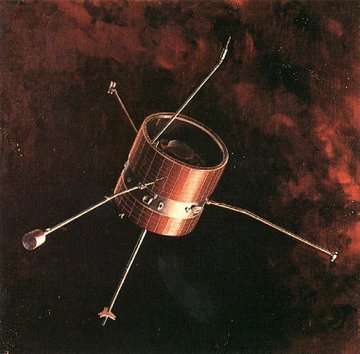Pioneer 6

Pioneer 6, 7, 8, and 9.
Pioneer 6 was the first of four identical solar orbiting, spin-stabilized spacecraft – Pioneer 6, 7, 8, and 9 – in the Pioneer series of deep space probes. Pioneer 6, launched in 1965 into a solar orbit, is the oldest of NASA's spacecraft believed to be still active. A successful contact was made with Pioneer 6 for about two hours on 8 December 2000 to commemorate its 35th anniversary.
The spacecraft's main body is an aluminum cylinder 94 centimeters (37 inches) in diameter and 89 centimeters (35 inches) long. There are three magnetometer booms, each 208 centimeters (82 inches) long. The antenna mast (pointing down in the picture) is 132 centimeters (52 inches) long. The mass is approximately 63 kilograms (138 pounds). 79 watts of power was generated from the solar panels. The spacecraft is spin-stabilized at approximately 60 rpm, with the spin axis perpendicular to the plane of the ecliptic.
Pioneers 6–9 demonstrated the practicality of spinning a spacecraft to stabilize it and to simplify control of its orientation. Measurements made by these spacecraft greatly increased our knowledge of the interplanetary environment and the effects of solar activity on Earth. New information was gathered about the solar wind, solar cosmic rays, the structure of the Sun's plasma and magnetic fields, the physics of particles in space, and the nature of storms on the Sun which produce solar flares. This series of spacecraft also discovered Earth's magnetotail (magnetic field tail away from the Sun). Simultaneous measurements by Pioneer 6 and 8 when they were 161 million kilometers apart allowed the most accurate determination of the solar wind density to be made up to that point.
| launch date | Dec 16, 1965 |
| launch vehicle | Delta E |
| launch site | Cape Canaveral |
| orbit | solar; periapsis 0.814 AU; apoapsis 0.983 AU; period 311 d; inclination 0.169-0.202° eccentricity 0.094 |
| other designations | Pioneer-A |
Some time after 15 December 1995 (almost 30 years after it was launched) Pioneer 6's primary transmitter (TWT) failed. During a track on 11 July 1996 the spacecraft was commanded to switch to the backup TWT, and the downlink signal was re-acquired. The spacecraft and a few of the science instruments were again functioning.
Pioneer 6 had a track on the 70-meter Deep Space Station 43 in Australia on 6 October 1997. Both the MIT and ARC Plasma Analyzers as well as the cosmic ray detector from University of Chicago were turned on and still worked after almost 32 years. Limited availability of NASA's Deep Space Network antennas and the greater scientific value of newer space missions led to a discontinuance of the tracking of the Pioneer 6–9 spacecraft. However, to mark its 35 years in orbit as the oldest functioning NASA spacecraft, one last contact was successfully completed on the 70-meter Deep Space Station 14 at Goldstone near Barstow, California on 8 December 2000.


